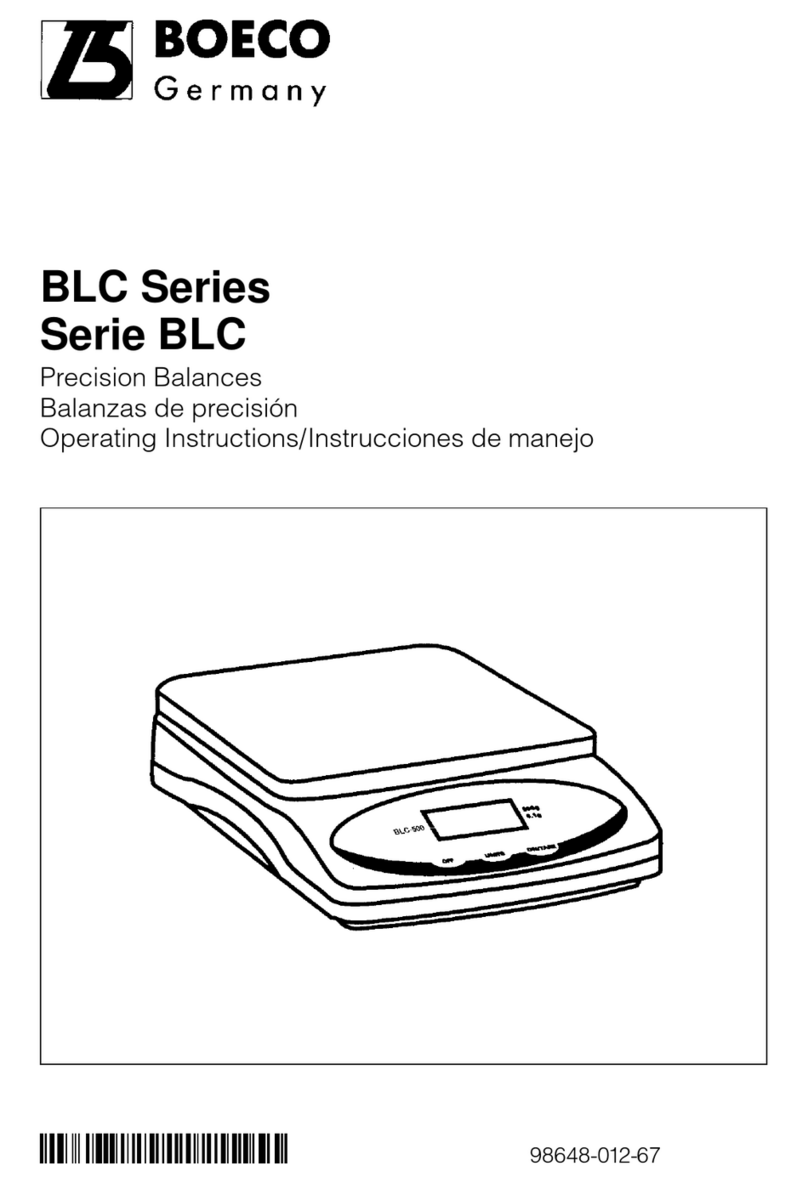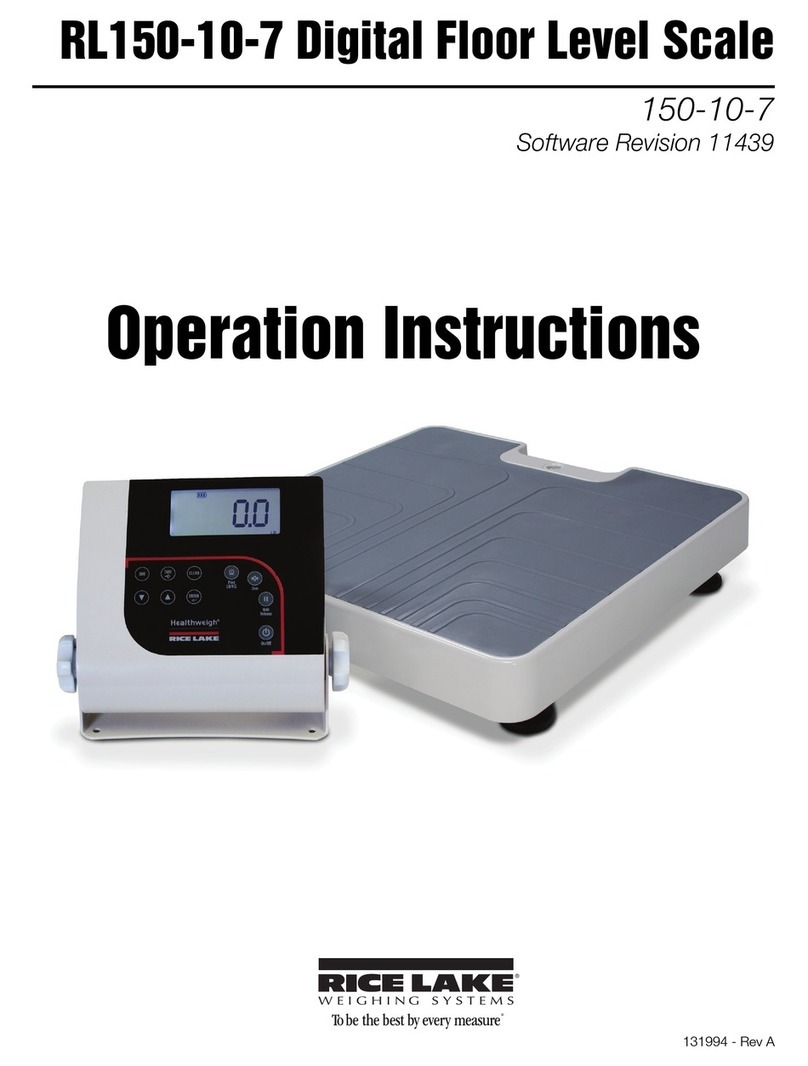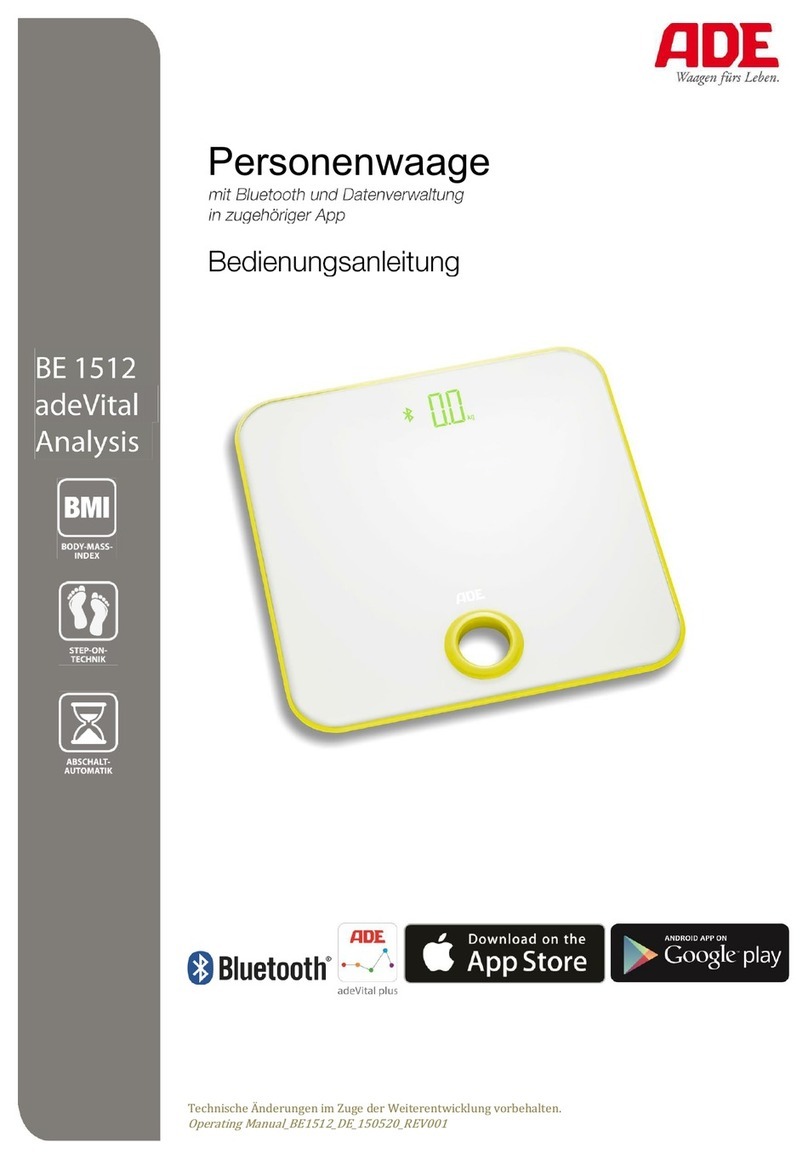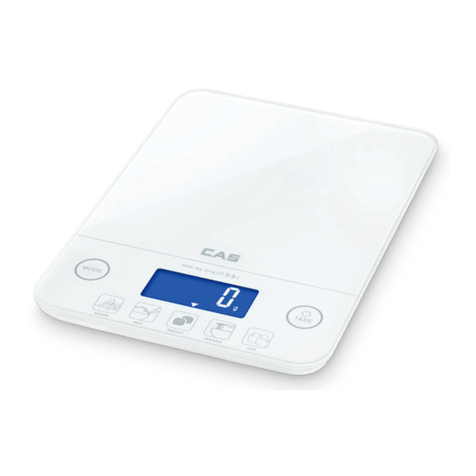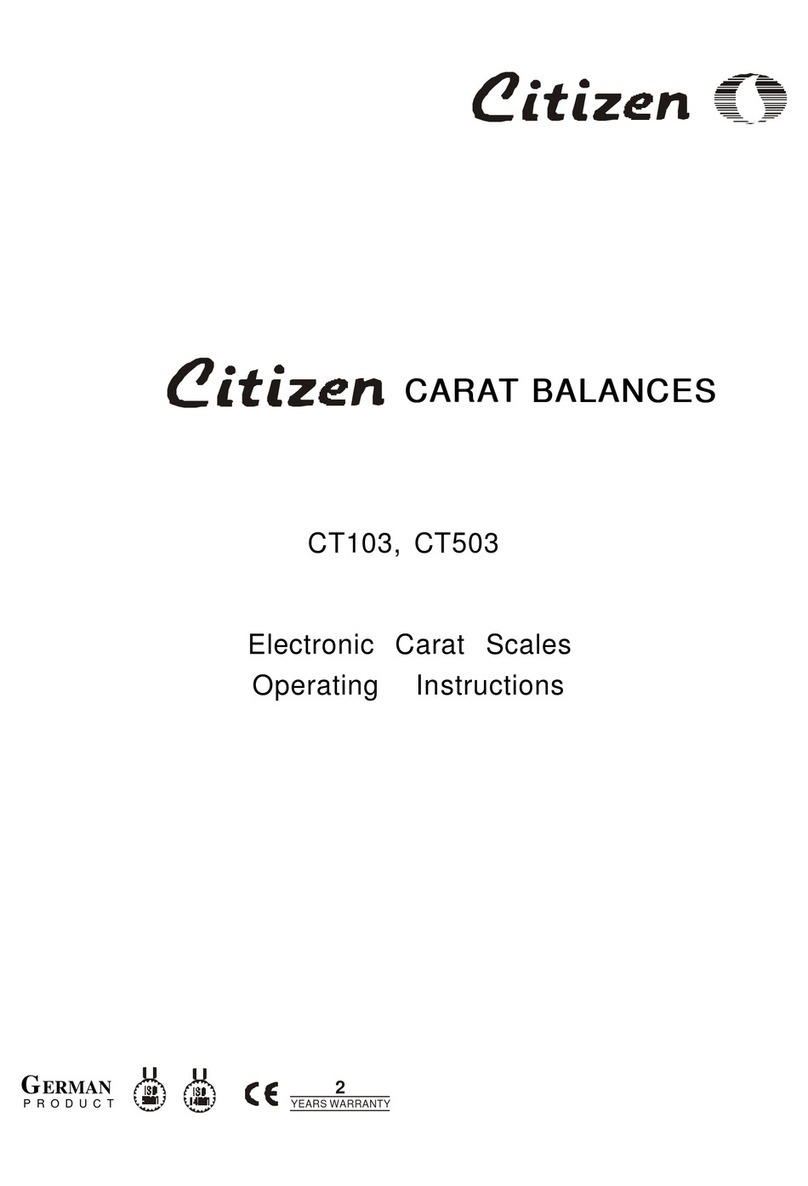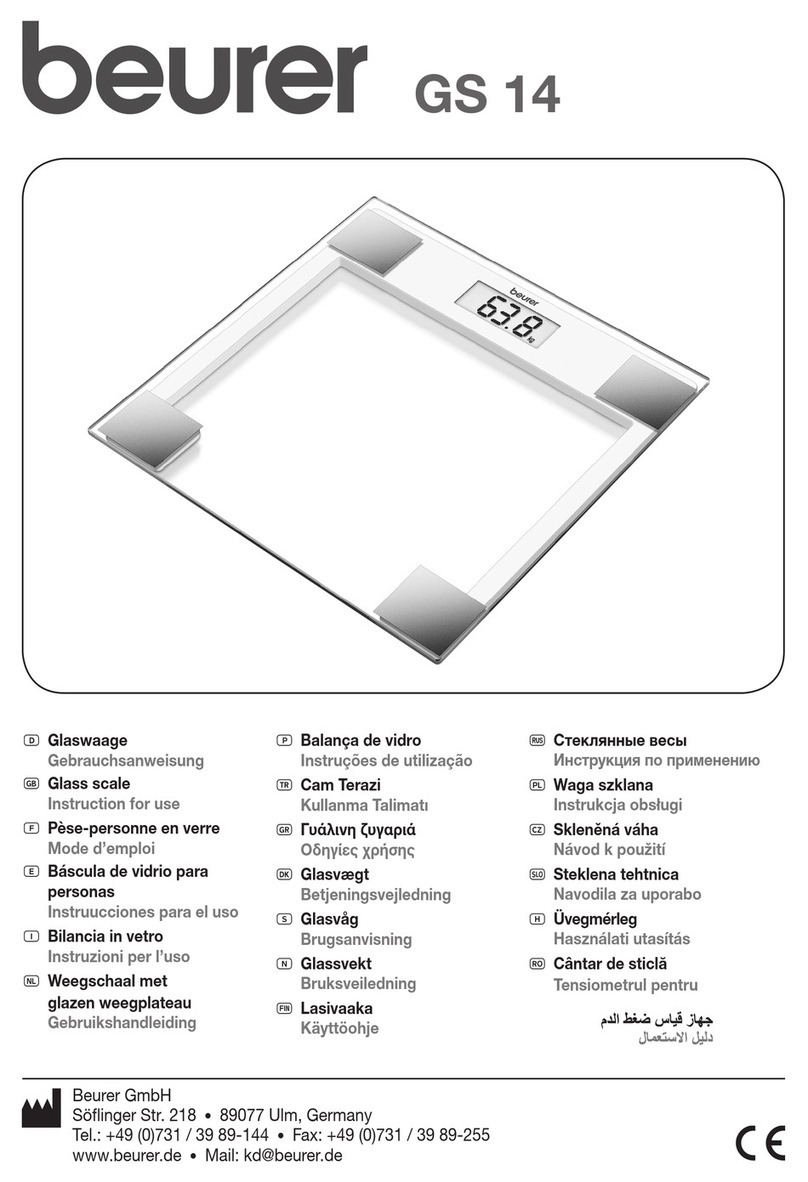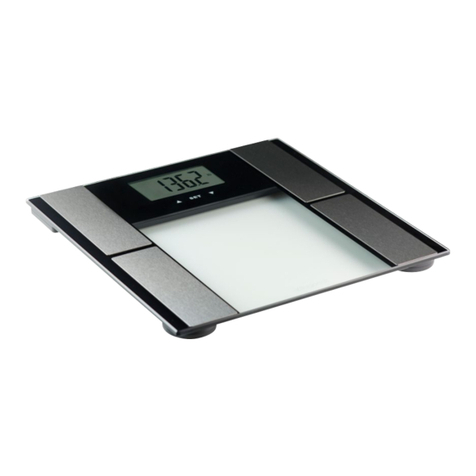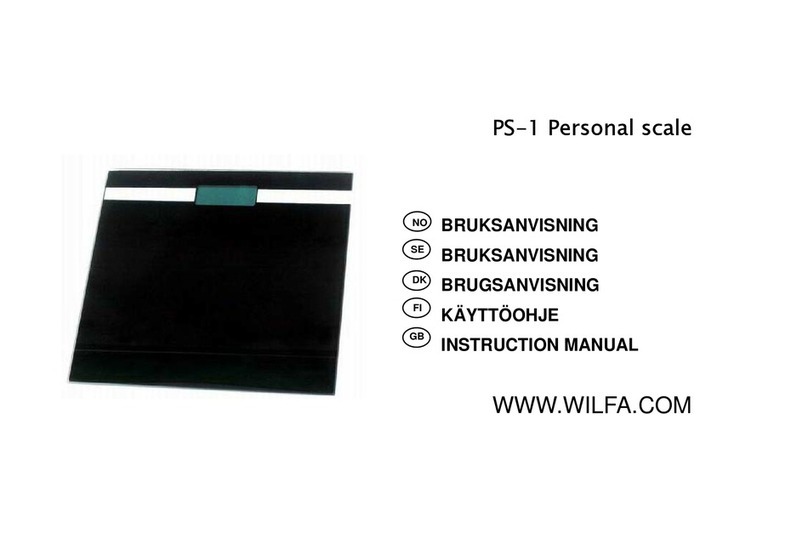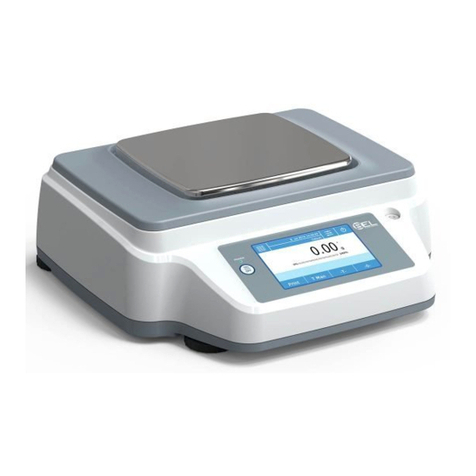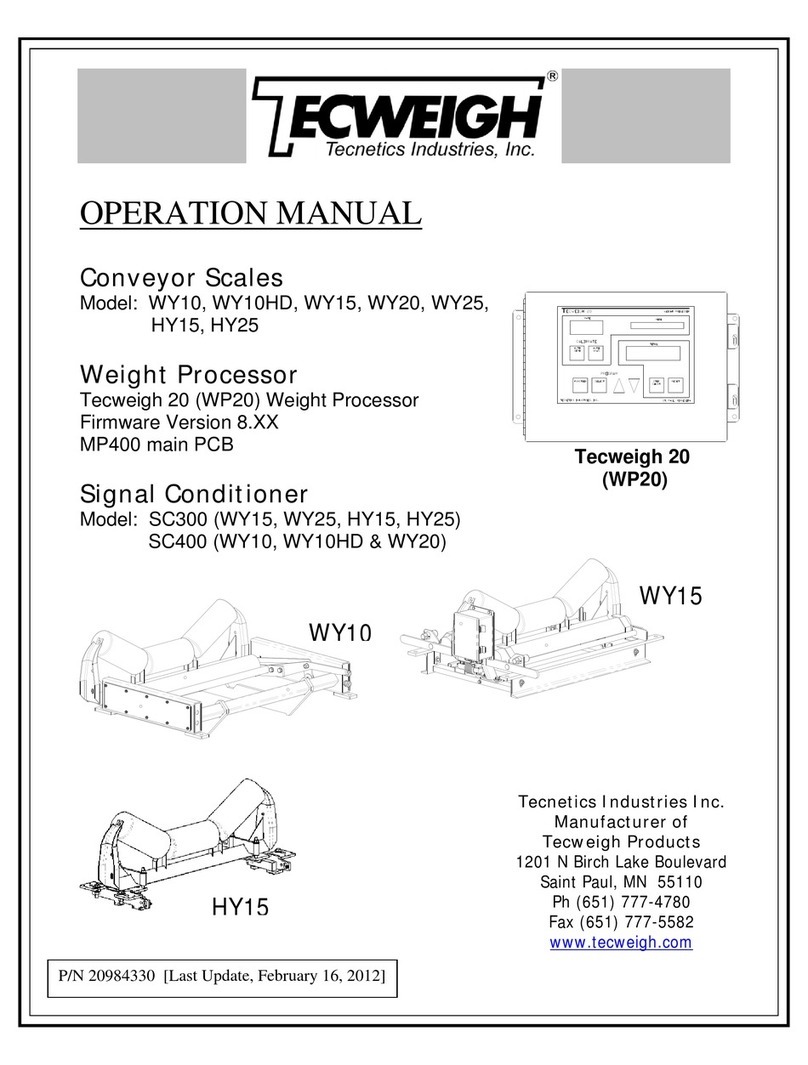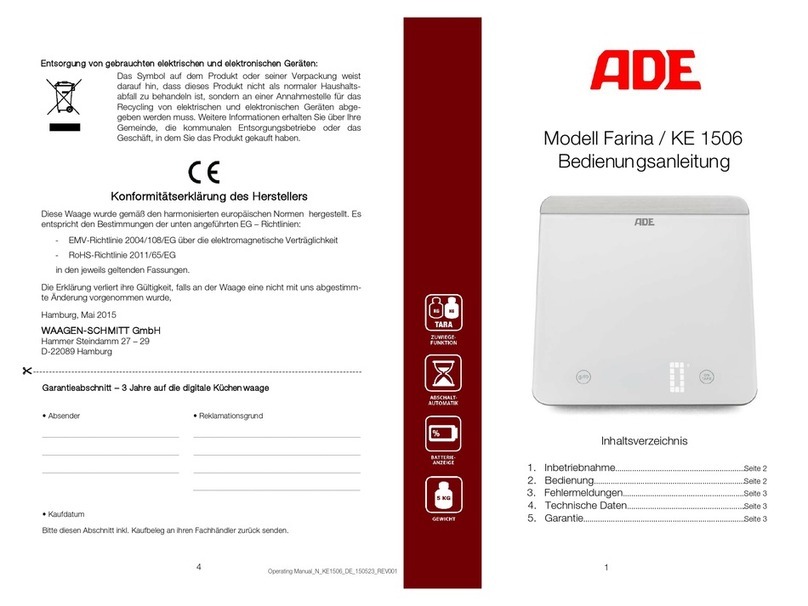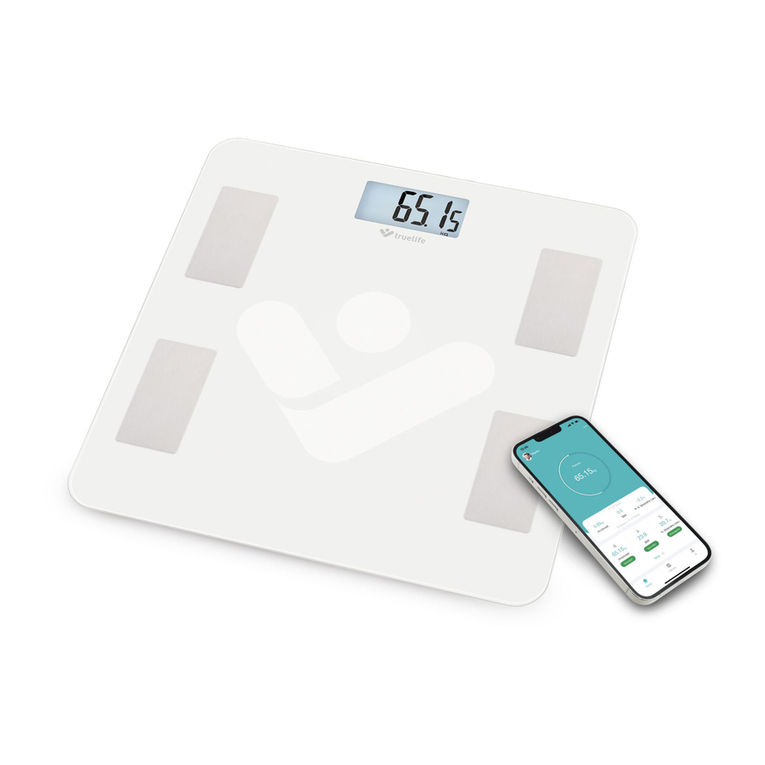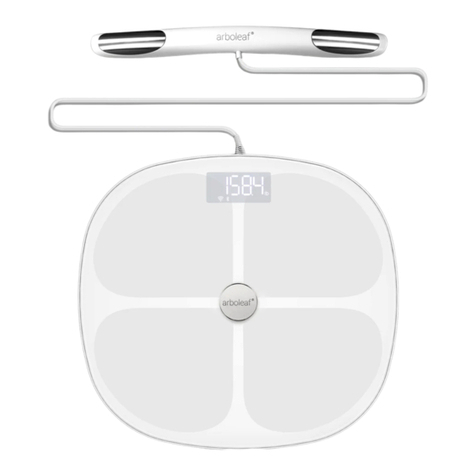Boeco BBL series User manual

BOECO
98648-012-04
BBL Models
Electronic Precision Balances
and Gold Scales
Operating Instructions
Modelos BBL
Balanzas electrónicas de precisión
para metales preciosos
Manual de instrucciones

2
English – page 3
Español – página 13

3
Intended Use
The BBL Series from BOECO offers precision balances with
capacities ranging from 0.1 mg to 6 kg.
These balances meet the highest requirements on
the accuracy and reliability of weighing results through
the following features:
– Efficient filtering-out of unfavorable ambient conditions
such as vibrations, drafts, etc.
– Stable and reproducible results
– Rugged, durable weighing system
BBL balances save work and speed up simple routine
applications through:
– Ultrafast response times
– Easy operation
You can also choose from the following extra functions
for simple applications:
– Toggling between weight units
– Net-total formulation (tare memory)
– Counting
– Weighing in percent
– Averaging
Contents
Page
Intended Use 3
Contents 3
Warning and Safety Information 3
Getting Started 3
Operation
Basic Weighing Function 5
Calibration/Adjustment 5
Application Programs
Counting 6
Weighing in Percent 6
Averaging 7
Net-Total Formulation/Second Tare Memory 8
Toggle between Weight Units 8
Configuration
Setting the Parameters (Menu Codes) 9
Balance Operating Menu (Overview) 9
Error Codes 10
Care and Maintenance 11
Instructions for Recycling 11
Overview
Specifications 12
CMarking 12
Warning and Safety Information
Read these operating instructions thoroughly before
using your balance to prevent damage to the equipment.
Keep these instructions in a safe place.
Follow the instructions below to ensure safe and trouble-free
operation of your balance:
!Make sure that the voltage rating printed on the AC
adapter is identical to your local line voltage
!Use only a commercially available 9-volt battery or
rechargeable battery
!Do not use this balance in a hazardous area/location
– The only way to turn the power off completely is
to disconnect the AC adapter
– Connect only BOECO accessories and options, as these
are optimally designed for use with your balance.
– Protect the AC adapter from contact with liquid.
Do not open the balance housing. If the seal is broken,
this will result in forfeiture of all claims under the
manufacturer’s warranty.
Getting Started
Storage and Shipping Conditions
Do not expose the balance to shocks, vibrations,
moisture or extreme temperatures.
Unpacking the Balance
§After unpacking the balance, check it immediately
for any visible damage as a result of rough handling
during shipment.
$If you see any sign of damage, proceed as directed
in the chapter entitled “Care and Maintenance,” under the
section on “Safety Inspection.”
Save the box and all parts of the packaging until you
have successfully installed your balance. Only the original
packaging provides the best protection for shipment.
Before packing your balance, unplug all connected cables
to prevent damage.
Equipment Supplied
The equipment supplied includes the components
listed below:
– Balance
– Weighing pan/load plate
– Pan support (only with models that have a round
weighing pan)
– Shield ring (only for BBL31-32)
– Shield plate (only for BBL31-32)
– Glass draft shield (only with model BBL42)
– AC adapter
– Dust cover (only for BBL31-32)
– Operating instructions (this manual)

4
Installation Instructions
Your balance is designed to provide reliable weighing results
under normal ambient conditions. When choosing a location
to set up your balance, observe the following so that you will
be able to work with added speed and accuracy:
– Set up the balance on a stable, even surface
– Avoid placing the balance in close proximity to a heater or
otherwise exposing the balance to heat or direct sunlight
– Protect the balance from drafts that come from open
windows or doors
– Avoid exposing the balance to extreme vibrations during
weighing
– Protect the balance from aggressive chemical vapors
– Do not expose the balance to extreme moisture over long
periods
Conditioning the Balance:
Moisture in the air can condense on the surfaces of a cold
balance whenever it is brought into a substantially warmer
place. If you transfer the balance to a warmer area, make
sure to condition it for about 2 hours at room temperature,
leaving it unplugged from AC power.
Setting up the Balance
Balances with an Analytical Draft
Shield Chamber:
§Place the components listed
below inside the chamber in
the order given:
– Shield plate
– Shield ring
– Pan support
– Weighing pan
Balances with a Glass
Draft Shield:
§Place the components listed
below on the balance in the
order given:
– Shield ring – place it on the
balance so that the edge for
fitting the glass draft shield
faces upwards and turn it until
it is firmly in place.
– Pan support
– Weighing pan
– Glass draft shield
– Draft shield cover
Balances with a Round Weighing
Pan Ø 115 mm
§Place the components
listed below on the balance
in the order given:
– Pan support
– Weighing pan
Balances with a Round Weighing
Pan Ø 150 mm
§Place the weighing pan
on the balance
Connecting the Balance to AC Power/Safety Precautions
Use only original AC adapters:
– for Europe: 6971948
– for the US: 6971947
– for the RSA: 6971949
– for Australia: 6971950
§Insert the right-angle plug into
the jack
§The AC adapter rated to
Class 2 can be plugged into
any wall outlet without
requiring any additional safety
precautions
The ground is connected to the balance housing, which can
be additionally grounded for operation.
Using a (Rechargeable) Battery
(not for models BBL31, BBL32, BBL42 or BBL52)
$Battery is not included with
the equipment supplied
!Use only a commercially
available (rechargeable)
9-volt battery
!When using a rechargeable
battery, always use an
external recharging device
to recharge the battery
§Lay the balance on its side
§Open the battery compart-
ment: Lift the compartment
cover
§Insert the 9-volt
(rechargeable) battery in
the compartment
$Make sure to connect
the positive and negative
poles correctly
!All used batteries are
classified as waste that
requires special handling
(not “household” waste).
Dispose of rechargeable
batteries in accordance with
the applicable special waste
disposal regulations.
§Close the battery compart-
ment: Press down on the
cover until it clicks into place

5
Leveling the Balance
(only for models BBL31, BBL32, BBL42 or BBL52)
Level the balance any time you
set it up in a new location.
Use only the 2 front feet of the
balance for leveling.
§Turn the 2 rear feet until they
are in position
(only on model BBL52)
§Turn the 2 front feet as shown
here in the illustration until the
air bubble is centered in the
level indicator
> In most cases this will require
several adjustment steps
Anti-theft Locking Device
To protect against theft, use the
mounting lug on the rear panel of
the balance.
§Secure the balance at the
place of installation,
for example with a chain
or a lock
Operation
Basic Weighing Function
Available Features
– Taring the balance
You can tare the balance within the entire weighing range.
Preparation
§Turn on the balance: Press [ON/OFF]
§To change configurations: See the chapter entitled
“Configuration”
§To load factory-set configurations:
See “Configuration,” parameter 9 – 1
$To tare the balance: Press t
Additional Functions
§To turn off the balance: Press [ON/OFF]
Warmup Time
To deliver exact results, the balance must warm up for
at least 30 minutes after initial connection to AC power. Only
after this time will the balance have reached the required
operating temperature.
Example
Basic weighing
Menu code settings: Factory-set codes
Step Key (or instruction) Display
1. Turn on the balance [ON/OFF]
Self-test is performed
2. Place container on balance + 52.0 g
(here: 52 g)
3. Tare the balance t+0.0 g
4. Place sample in container + 150.2 g
on balance (here: 150.2 g)
Calibration/Adjustment*
Always calibrate/adjust the balance after setting it up in
a new location.
Available Features
Calibration/adjustment can only be performed when
– there is no load on the balance,
– the balance is tared, and
– the internal signal is stable.
If these conditions are not met, an error message
is displayed. Otherwise, the weight required for calibration/
adjustment is displayed.
Calibration/adjustment can be performed with any of three
weight units: g, kg1), or lb (menu code 1. 4. x)
Factory setting: Grams (menu code 1. 4. 1)
1) not for models with a readability of 0.1 mg
Example
Calibrate the balance
Menu code settings: Factory-set codes
Step Key (or instruction) Display
1. Turn on the balance [ON/OFF]
2. Tare the balance t0.0 g
3. Begin calibration [CAL/CF] +1000.0
Calibration weight is
displayed without
weight unit (here: 1000 g)
4. Place the indicated 1000.0
calibration weight
on the balance
After calibration, the +1000.0 g
calibration weight
is displayed with wt. unit
5. Remove the 0.0 g
calibration weight
* “Calibration” technically means to determine the difference between the
balance readout and the actual weight on the pan to determine the accuracy.
Adjustment means to bring a balance into the state of accuracy required for
its use. Therefore, “calibration,” as used in this manual, actually means
“adjustment.”

6
Application Programs
Counting
Purpose
With the Counting program you can determine the number
of parts that each have approximately equal weight.
Available Features
– Store the current weight value to have it loaded as the
preset reference sample quantity next time you initialize
the Counting application
– The reference sample quantity can be changed in the
operating menu: See “Configuration”
– The average piece weight is automatically output via the
optional data interface port after initialization, if the menu
code for “Printout with data ID codes” is set
– Press [FUNCTION] to toggle the display between piece
count and weight
Factory Settings
Reference sample quantity: 10 (menu code 3. 3. 2)
Preparation
§Configure the Counting application in the operating menu:
See “Configuration”
Menu code 2. 1. 4 Counting
§Reference sample quantity:
Menu code 3. 3. 1 5 pcs
Menu code 3. 3. 2 10 pcs
Menu code 3. 3. 3 20 pcs
Menu code 3. 3. 4 50 pcs
Menu code 3. 3. 5 100 pcs
See also “Configuration”
Example
Determine an unknown piece count; weigh the preset
reference sample quantity
Settings (changes in the factory settings required for
this example):
Menu: Application program: Counting (2 1 4)
Reference sample quantity: 20 pcs (3. 3. 3)
Step Key (or instruction) Display
1. Turn on the balance [ON/OFF]
2. Tare the balance t0.0 g
3. Display the reference [FUNCTION] ref 20 (briefly)
sample quantity > 2 sec.
(here: 20 pcs)
4. Place the reference sample + 66.0 g
quantity (20 pcs) on the
balance (here: 66 g)
5. Start the application; [FUNCTION] + 20 pcs
if the print format is set
to include data ID codes,
the following is printed wRef + 3.300 g
6. Weigh uncounted parts + 174 pcs
(here: 174 pcs)
7. Display weight [FUNCTION] + 574.2 pcs
8. Display quantity [FUNCTION] + 174 pcs
9. Unload the balance 0pcs
10. Delete the reference
value [CAL/CF] > 2 sec.
11. Repeat the procedure
starting from Step 6,
if desired.
Weighing in Percent
Purpose
This application program allows you to obtain weight read-
outs in percent which are in proportion to a reference weight.
Available Features
– Store the current weight value to have it loaded as
the preset reference percentage next time you initialize
the Weighing in Percent application
– The reference percentage can be changed in the
operating menu: See “Configuration”
– The reference percentage is automatically output via the
optional data interface port after initialization, if the menu
code for “Printout with data ID codes” is set
– Press [FUNCTION] to toggle the display between
percentage and weight
Factory Settings
Reference percentage: 10 (menu code 3. 3. 2)

7
Preparation
§Configure the Weighing in percent application
in the operating menu: See “Configuration”
Menu code 2. 1. 5 Weighing in percent
§Reference percentage:
Menu code 3. 3. 1 5 %
Menu code 3. 3. 2 10 %
Menu code 3. 3. 3 20 %
Menu code 3. 3. 4 50 %
Menu code 3. 3. 5 100 %
See also “Configuration”
Example
Determine an unknown percentage; store the weight on
the balance as a reference percentage
Settings (changes in the factory settings required for
this example):
Menu: Application program: Weighing in percent (2 1 5)
Menu: Reference percentage 100 % (3 3 5)
Step Key (or instruction) Display
1. Turn on the balance [ON/OFF]
2. Tare the balance t0.0 g
3. Display the reference [FUNCTION] ref100
percentage > 2 sec.
4. Place the reference weight + 222.5 g
for 100% on the balance
(here: 222.5 g)
5. Start application; [FUNCTION] +100.00 %
if the print format is set
to include data ID codes, Wxx% + 222.500 g
the following is printed
6. Place an unknown weight +144.94 %
on the balance
(here: 322.5 g)
7. Display weight [FUNCTION] + 322.5 g
8. Display percentage [FUNCTION] +144.94 %
9. Unload the balance 0.00 %
10. Delete the reference [CAL/CF] > 2 sec.
percentage
11. Repeat the procedure
starting from Step 6,
if desired.
Averaging
Purpose
Use this program to determine weights under unstable
ambient conditions. In this program, the balance calculates
the weight as the average value from a defined number of
individual weighing operations. These weighing operations
are also known as “subweighing operations” or “subweighs.”
Available Features
– The measured result displayed is the arithmetic mean
shown in the selected weight unit; a triangle under the plus
or minus sign indicates that this is a calculated value
– You can set the number of subweighing operations
performed in the operating menu: See “Configuration”
– Press [FUNCTION] for at least 2 sec. to display
the pre-set number of subweighing operations
– Press [FUNCTION] to toggle the display between
the calculated result and the weight
Factory Settings
Number of subweighs for averaging: 10 (3. 3. 2)
Preparation
§Configure the Averaging application in the operating
menu: See “Configuration”
Menu code 2. 1.12 Averaging
– Number of subweighs for averaging:
3. 3. 1 5 subweighs
3. 3. 2 10 subweighs
3. 3. 3 20 subweighs
3. 3. 4 50 subweighs
3. 3. 5 100 subweighs
See also “Configuration”
Example
Determine the weight of a sample in extremely
unstable ambient conditions by calculating the average
of 10 subweighing operations.
Settings (changes in the factory settings required
for this example):
Menu: Application program: Averaging (menu code 2. 1.12)
Step Key (or instruction) Display
1. Turn on the balance [ON/OFF]
2. Tare the balance t0.0 g
3. Display the number [FUNCTION] ref 10 (briefly)
of subweighs (here: 10) > 2 sec.
4. Place sample on the balance + 8888
(weight readout fluctuates;
here: around 275 g)
5. Start measurement [FUNCTION] + 8888
10
9
8
...
1
After 10 subweighs + 275.5 g G
If the print format is set
to include data ID codes,
the following is printed RES + 275.5 g
6. Unload the balance + 275.5 g G
(stable display)
7. Delete the result [CAL/CF] > 2 sec.
8. Repeat the procedure starting
from Step 4, if desired.

8
Net-Total Formulation/Second Tare
Memory
With this application program you can weigh in components
for formulation of a mixture.
Preparation
Configure the Net-total formulation/Second tare memory
application in the operating menu: See “Configuration”
Menu code 2.1. 3
Example
Step Key (or instruction) Display
1. Turn on the balance [ON/OFF]
2. Place an empty container + 65.0 g
on the balance
3. Tare the balance t
4. Add the first component + 120,5 g
5. Store the first component [FUNCTION] 0.0 gNET
weight
If the print format is set
to include data ID codes,
the following is printed N1 + 120.5 g
6. Add the next component + 70,5 g
7. Store the 2nd component [FUNCTION] 0.0 gNET
weight
8. Add further components, As described
if desired for Steps 5 and 6
9. Display total weight [CAL/CF] > 2 sec. + 191,0 g
and fill to desired
final weight
Toggle between Weight Units
With this application program you can toggle the display
of a weight value back and forth between two weight units.
Configure the “Toggle weight units” application in the
operating menu:
See “Configuration” menu code 2.1. 2 Toggle weight units
Menu code Unit Conversion factor Abbr. on
printout
1. 7. 2 o3. 1. 2 oGrams 1.00000000000 g
1. 7. 31)3. 1. 31) Kilograms 0.00100000000 kg
1. 7. 4 3. 1. 4 Carats 5.00000000000 ct
1. 7. 5 3. 1. 5 Pounds 0.00220462260 lb
1. 7. 6 3. 1. 6 Ounces 0.03527396200 oz
1. 7. 7 3. 1. 7 Troy ounces 0.03215074700 ozt
1. 7. 8 3. 1. 8 Hong Kong taels 0.02671725000 tlh
1. 7. 9 3. 1. 9 Singapore taels 0.02645544638 tls
1. 7. 10 3. 1. 10 Taiwanese taels 0.02666666000 tlt
1. 7. 11 3. 1. 11 Grains 15.43235835000 GN
1. 7. 12 3. 1. 12 Pennyweights 0.64301493100 dwt
1. 7. 13 3. 1. 13 Milligrams 1000.00000000000 mg
1. 7. 14 3. 1. 14 Parts per pound 1.12876677120 /lb
1. 7. 15 3. 1. 15 Chinese taels 0.02645547175 tlc
1. 7. 16 3. 1. 16 Mommes 0.26670000000 mom
1. 7. 17 3. 1. 17 Austrian carats 5.00000000000 K
1. 7. 18 3. 1. 18 Tola 0.08573333810 tol
1. 7. 19 3. 1. 19 Baht 0.06578947437 bat
1. 7. 20 3. 1. 20 Mesghal 0.21700000000 MS
o= Factory setting
1) = not for models with a readability of 0.1 mg
Function
§To toggle the display between the 1st and 2nd weight
units: Press the [FUNCTION] key

9
Configuration
Setting the Parameters (Menu Codes)
You can configure your BBL balance to meet individual
requirements by selecting from the parameters available
in the menu.
Example: Adapt the balance to unstable ambient
conditions: Menu code 1 1 4
Step Key (or instruction) Display
1. Turn off the balance [ON/OFF]
2. Turn the balance back on [ON/OFF]
while all segments tbriefly
are displayed 1.
$To navigate within a menu t2.
level; the last menu repeatedly ...
option is followed by the 9.
first option 1.
3. Select the 2nd menu level [PRINT] 1. 1.
4. Select the 3rd menu level [PRINT] 1. 1. 2 o
5. In Menu Level 3: t1. 1. 4
Select the desired option repeatedly
6. Confirm new setting; the
“o” indicates the currently
set option [PRINT] for 2 sec. 1. 1. 4 o
$Select the next menu level
(here: move from the 3rd to
the 1st level) [PRINT] 1.
$Set other menu codes, [PRINT], t
if desired
7. Store parameter settings t
and exit operating menu for 2 sec.
or
$Exit operating menu without
storing changes [ON/OFF]
> Restart the application 0.0 g
Balance Operating Menu (Overview)
oFactory setting
√User setting
Menu 1. Balance 1.1. Adapt filter 1.1.1 Minimum vibration
functions 1.1.2 oNormal vibration
1.1.3 Strong vibration
1.1.4 Extreme vibration
1.3. Stability range 1.3.1 1/4 digit
1.3.2 1/2 digit
1.3.3 1 digit
1.3.4 o2 digits
1.3.5 4 digits
1.4. Weight unit 1.4.1 oGrams
for calibration 1.4.2 Kilograms*
weight 1.4.3 Pounds
1.6. Auto zero 1.6.1 oOn
1.6.2 Off
1.7. Weight unit 1 See “Toggle between
Weight Units”
2. Application 2.1. Program see the desired application
programs selection program description
3. Application 3.1. Weight unit 2 see “Toggle between
Weight Units”
3.3. Reference qty see the desired application
or % program description
5. through 7. applies only if an interface is installed;
see the corresponding instructions
8. Extra 8.1. Menu 8.1.1 oParameter settings
functions alterable
8.1.2 Parameter settings
read only
8.2. External applies only if an interface
switch function is installed; see the
corresponding instructions
8.3. Power-on 8.3.1 Off/on (battery
mode shuts off
automatically after
3 min)
8.3.2 oStand-by/on
9. Reset menu 9.– Factory 9.– 1 Reset
settings 9.– 2 oDo not reset
* = not for models with a readability of 0.1 mg
Menu level 1
Menu level 2
Menu level 3
Factory setting
Menu level 4

10
Error Codes
Error codes are shown on the main display for approx. 2 seconds, after which the program automatically returns
to the weighing mode.
Display Cause Solution
No segments appear on No AC power is available Check the AC power supply
the display The AC adapter is not plugged in Plug in the AC adapter
Battery is dead Replace the battery
Recharge the battery using
an external recharging device
hThe load exceeds the Unload the balance
balance capacity
lThe weighing pan/load plate Place the weighing pan/load plate
is not in place on the balance
Something is touching the Move the object that is touching the
weighing pan/load plate weighing pan/load place
e 01 Display capacity exceeded: Decrease the weight on the scale
Value to be output cannot be
shown on the display
e 02 Calibration parameter Calibrate only when zero is displayed
not met; e.g.:
– balance not zeroed Press tto tare the balance
– balance is loaded Unload the balance
e 09 When gross <zero, no tare Tare the balance
e 10 The tkey is blocked Press [CAL/CF] > 2 sec. to clear the tare
when there is data in memory and release the tare key
the second tare memory
(net-total) – only 1 tare function
can be used at a time
e 11 Value input is not allowed for Press t
second tare memory
e 22 Weight is too light or there is Increase the reference quantity
no sample on the balance
e 30 Interface port for printer Contact your local
output is blocked Service Center
Max. weighing range is less The balance was turned on Place the weighing pan on
than indicated under ”Specifications” without the weighing pan in place on the balance and press [ON/OFF]
to turn on the balance
The weight readout The balance has not Calibrate/adjust the balance
is obviously wrong been calibrated/adjusted
The balance was not Tare before weighing
tared before weighing
If any other errors occur, contact your local Service Center!

11
Care and Maintenance
Repairs
Repair work must be performed by trained service
technicians. Any attempt by untrained persons to perform
repairs may lead to hazards for the user.
Cleaning
!Disconnect the balance from the AC adapter and unplug
any data cables that are connected to the balance
!Make sure that no liquid enters the balance housing
!Do not use any aggressive cleaning agents
(solvents or similar agents)
§Clean the balance using a piece of cloth which has been
wet with a mild detergent (soap)
§After cleaning, wipe down the balance with a soft,
dry cloth
Removing and Cleaning the
Weighing Pan:
§Lift up and remove the
weighing pan together with
the pan support by gripping
them from under the shield
ring. Make sure that you
do not damage the weighing
system in doing so.
Safety Inspection
If there is any indication that safe operation of the balance
with the AC adapter is no longer warranted:
§Turn off the power and disconnect the equipment
from AC power immediately
> Lock the equipment in a secure place to ensure
that it cannot be used for the time being
Safe operation of the balance with the AC adapter is no
longer ensured when:
– there is visible damage to the AC adapter
– the AC adapter no longer functions properly
– The AC adapter has been stored for a relatively long
period under unfavorable conditions
In this case, notify your nearest Service Center or the
International Technical Support Unit. Maintenance and repair
work may only be performed by service technicians who are
authorized by BOECO and who
– have access to the required maintenance manuals
– have attended the relevant service training courses
Instructions for Recycling
the Packaging
To ensure safe shipment, your balance has been packaged
using environmentally friendly materials. After successful
installation of the balance, you should return this packaging
for recycling.
For information on recycling options, including recycling
of old weighing equipment, contact your municipal waste
disposal center or local recycling depot.

12
Overview
Specifications
General specifications:
AC power source/power AC adapter, 230 or 115 V,
requirements + 15%...–20%
Frequency 48–60 Hz
Power requirements,
direct current V 10 to 20
Adaption to ambient By selection of 1 of 4 optimized
conditions filter levels
Display update (depends on
the filter level selected) 0.1–0.4
Specifications for the individual models:
BBL Series
Model BBL31 BBL32
Weighing capacity g 210 120
Readability mg 0.1 0.1
Tare range (subtractive) g 210 120
Repeatability ≤±mg 0.1 0.1
Linearity ≤±mg 0.2 0.2
Sensitivity drift within
+10…+30 °C/+50…+86°F ≤±/K 2·10–6 2·10–6
Response time (average) s 3 3
External calibration weight g 200 (E2) 100 (E2)
(of at least accuracy class…) lb 0.4 (E2) 0.2 (E2)
Net weight, approx. kg 3.0 3.0
Pan size mm 80 Ø 80 Ø
Power consumption (average) W 1.0
Operating temperature range +10…+30 °C (273…303 K)
(50…86 °F)
Dimensions (W×D×H) mm 189×251×300
BBL Series
Model BBL42 BBL52 BBL53 BBL54
Weighing capacity g 150 1,500 610 310
Readability g 0.001 0.01 0.01 0.01
Tare range (subtractive) g 150 1,500 610 310
Repeatability ≤±g 0.0015 0.015 0.01 0.01
Linearity ≤±g 0.003 0.03 0.02 0.02
Sensitivity drift within
+10…+30 °C/+50…+86°F ≤±/K 3.3·10–6 3.3·10–6 0.5·10–5 1·10–5
Response time (average) s 2.5 2.5 2 2
External calibration weight g 100 (F1) 1000 (F1) 500 (F2) 100(F2)
(of at least accuracy class…) lb 0.2 (F1) 2 (F1) 1 (F2) 0.2 (F2)
Net weight, approx. kg 1.6 1.4 1.1 1.1
Pan size mm 100 Ø 150 Ø 115 Ø 115 Ø
Hours of operation:
– with 9-volt battery, approx. h – – 11 11
– with fully charged rechargeable
9-volt battery, approx. h – – 2.5 2.5
Power consumption (average) W 0.75
Operating temperature range
0…+40 °C (263…313 K, 32 °F…104 °F)
Dimensions (W×D×H) mm 189×251×70
(without glass draft shield cylinder)
BBL Series
Model BBL61 BBL62 BBL63 BBL64 BBL71
Weighing capacity g 6,100 3,100 1,500 610 6,000
Readability g 0.1 0.1 0.1 0.1 1
Tare range (subtractive) g 6,100 3,100 1,500 610 6
Repeatability ≤±g 0.1 0.1 0.1 0.1 1
Linearity ≤±g 0.2 0.2 0.2 0.2 2
Sensitivity drift within
+10…+30 °C/+50…+86°F ≤±/K 0,5·10–5 1·10–5 2·10–5 5·10–5 5·10–5
Response time (average) s 2 2 2 2 2
External calibration weight g 5,000 1,000 1,000 500 5,000
(of at least accuracy class…) (F2) (F2) (M1) (M1) (M1)
lb 10,000 2,000 2,000 1,000 10,000
(F2) (F2) (M1) (M1) (M1)
Net weight, approx. kg 1.4 1.4 1.4 1.4 1.4
Pan size mm 150 Ø
Hours of operation:
– with 9-volt battery, approx. h 11 11 11 11 11
– with fully charged
rechargeable 9-volt battery,
approx. h 2.5 2.5 2.5 2.5 2.5
Power consumption (average) W 0.75
Operating temperature range 0…+40 °C (263…313 K, 32 °F…104 °F)
Dimensions (W×D×H) mm 189×251×70
(without glass draft shield cylinder)
CMarking
The Cmarking affixed to the equipment indicates that the
equipment meets the requirements of the following Directive(s):
Council Directive 89/336/EEC
“Electromagnetic compatibility (EMC)”
Applicable European Standards:
Limitation of emissions:
According to Product Standard EN61326-1 Kl.B
(Residential environment)
Defined Immunity to Interference:
According to Product Standard EN61326-1
(Industrial environment)
Important Note:
The operator shall be responsible for any modifications to
BOECO equipment and for any connections of cables or
equipment not supplied by BOECO and must check and,
if necessary, correct these modifications and connections.
On request, BOECO will provide information on the minimum
operating specifications (in accordance with the Standards
listed above for defined immunity to interference).
Council Directive 73/23/EEC
“Electrical equipment designed for use within
certain voltage limits”
Applicable European Standards:
EN 60950 Safety of information technology equipment
including electrical business equipment
EN 61010 Safety requirements for electrical equipment
for measurement, control and laboratory use
Part 1: General requirements
If you use electrical equipment in installations and under
ambient conditions requiring higher safety standards,
you must comply with the provisions as specified in the
applicable regulations for installation in your country.

13
Uso
La serie BBL está compuesta de balanzas para la pesada
de muestras desde 0,1 mg hasta 6 kg.
Las balanzas garantizan resultados de pesada fiables
mediante:
– filtración de las condiciones ambientales desfavorables,
p. ej. vibraciones, corrientes de aire, etc.
– resultados de pesada reproducibles
– diseño robusto
Las balanzas BBL simplifican y aceleran los procesos
de rutina mediante:
– tiempos de medición breves
– manejo fácil
Una función adicional para aplicaciones simples
a seleccionar entre:
– conmutación de unidad de peso
– total-neto (segunda memoria de tara)
– conteo
– pesada en porcentaje
– formación del valor promedio
Contenido
Página
Uso 13
Contenido 13
Advertencias de seguridad 13
Puesta en funcionamiento 14
Funcionamiento
Función básica “Pesar” 15
Calibrar/ajustar 15
Programas de aplicaciones
Conteo 16
Pesada en porcentaje 16
Formación del valor promedio 17
Total neto/segunda memoria de tara 18
Conmutación de unidades 18
Ajustes previos
Ajustar parámetros (menú) 19
Ajustes de parámetros (sinopsis) 19
Mensajes de error 20
Cuidado y mantenimiento 21
Eliminación de desechos, reciclado 21
Sinopsis
Datos técnicos 22
Marca C22
Advertencias de seguridad
Lea atentamente las instrucciones de manejo, antes de
la puesta en funcionamiento del aparato. De esta manera
se evitarán daños. Conserve y cuide este manual de
instrucciones.
Han de observarse las siguientes advertencias para
un funcionamiento seguro y sin problemas de la balanza:
!el valor de tensión impreso en el adaptador de CA
debe concordar con la tensión de red local
!utilizar sólo baterías block de 9 voltios, o bien, equipo
de baterías recargables
!no emplear en áreas con peligro de explosión
– las conexiones en la balanza deben realizarse sólo con
balanza desconectada de la red de alimentación
– utilizar accesorios y opciones de BOECO, ya que estos
se ajustan en forma óptima a la balanza
– proteger el adaptador de CA contra la humedad
No abrir la balanza. Al violarse las marcas de sello,
los derechos de garantía carecerán de validez.
Puesta en funcionamiento
Condiciones de transporte y almacenamiento
No exponga el aparato a temperaturas extremas,
golpes, vibraciones y humedad.
Desembalar
§Controle el aparato de inmediato al desembalar, para
detectar daños eventuales visibles exteriormente
$En caso de existir algún daño, ver en
“Controles de seguridad”
Conserve todas las partes del embalaje para algún envío
eventual necesario, ya que un transporte libre de riesgos
se garantiza sólo con embalaje original; al enviar, separe
todas las conexiones de cables, con el fin de evitar daños
innecesarios.
Equipo suministrado
Se suministran los siguientes componentes
– balanza
– platillo de pesada
– soporte de platillo (sólo en los modelos con platillo
redondo)
– protector de vidrio contra corrientes de aire
(sólo para el modelo BBL42)
– anillo de blindaje (sólo en BBL31-32)
– placa de blindaje (sólo en BBL31-32)
– adaptador de CA
– cubierta protectora (sólo en BBL31-32)
– manual de instrucciones

14
Advertencias de instalación
La balanza está construida de tal manera que, al funcionar
bajo condiciones normales de empleo, se obtendrán
resultados fiables de medición. La balanza trabaja en forma
exacta y rápida, si se ha elegido el lugar apropiado de
instalación:
– colocar la balanza sobre una superficie plana y estable
– evitar los calores extremos que se producen al instalar
la balanza cerca de calefactores o al exponerla
directamente a los rayos solares
– proteger la balanza contra las corrientes directas de aire
(ventanas y puertas abiertas)
– evitar las vibraciones fuertes durante la medición
–
proteger la balanza contra emanaciones químicas agresivas
– evitar humedades extremas
Aclimatar la balanza:
Una condensación (de la humedad del aire en el aparato)
se puede producir, si un aparato que está frío se instala en
un ambiente mucho más temperado. Dejar que el aparato,
separado de la tensión de red, se aclimate por aprox. 2
horas a la temperatura del ambiente.
Instalar la balanza
Balanzas con protector contra
corrientes de aire rectangular:
§Montar los componentes
en el siguiente orden:
– placa de blindaje
– anillo de blindaje
– soporte de platillo
– platillo de pesada
Balanzas con protector
de vidrio contra corrientes de
aire redondo
§Montar componentes:
– colocar en la balanza la tapa
inferior con el borde hacia
arriba y girar, hasta quedar fijo
– soporte del platillo de pesada
– platillo de pesada
– protector de vidrio contra las
corrientes de aire
– tapa superior con el borde
hacia abajo
Balanzas con platillo de pesada
redondo Ø 115 mm
§Montar componentes:
– soporte del platillo de pesada
– platillo de pesada
Balanzas con plato de pesada
redondo Ø 150 mm
§Montar el plato de pesada
Conexión a la red/medidas de protección
Utilice sólo adaptadores de
CA originales
– en Europa: 6971948
– en EE.UU.: 6971947
– en la República
Sudafricana: 6971949
– en Australia: 6971950
§insertar enchufe angular en
la balanza
§los adaptadores de CA de la
clase de protección 2 pueden
conectarse en cualquier
enchufe tomacorriente, sin
necesidad de tomar medidas
de seguridad especiales
La tensión de salida está puesta a tierra mediante un polo
que se conecta con la carcasa de la balanza. La carcasa
de la balanza, por motivos funcionales, también puede ser
puesta a tierra.
Utilización de batería/equipo de baterías
(excepto en los modelos BBL31, BBL32, BBL42 ó BBL52)
$La batería o equipo de
baterías no pertenecen al
suministro de balanza
!Utilizar sólo baterías block
de 9 voltios adquiribles
en el comercio o equipo de
baterías
!Cargar equipo de baterías con
aparato de recargar externo
§Volcar la balanza
§Abrir compartimento para
batería: quitar tapa del
compartimento
§Colocar batería block de
9 voltios o equipo de baterías
en el compartimento
$Observar la polaridad
!Baterías utilizadas o equipos
de baterías son desechos
especiales (no es basura
domiciliaria): eliminar equipos
de baterías en forma especial,
según la reglamentación para
los residuos industriales
§Cerrar compartimento para
baterías: insertar la tapa del
compartimento, presionándola

15
Nivelar la balanza
(sólo en los modelos BBL31, BBL32, BBL42 ó BBL52)
Nivelar la balanza cada vez que
se cambie de lugar de instalación.
La nivelación se realiza girando
sólo las dos patas de regulación
delanteras.
§Apretar girando las patas
de apoyo traseras (sólo en los
modelos BBL52)
§Girar las patas atornillables
delanteras, como lo representa
el dibujo adjunto, hasta que la
burbuja del nivel quede en el
centro del círculo
> Por regla general, se requieren
varios pasos para nivelar
Seguro antirrobo
Como seguro antirrobo utilizar la
orejeta para la fijación, en la parte
trasera de la balanza
§Fijar la balanza en el lugar
de instalación con una cadena
o candado
Funcionamiento
Función básica “Pesar”
Características
– Tarar balanza
La tara puede realizarse dentro del rango completo de
pesada de la balanza.
Preparación
§Encender balanza: pulsar tecla [ON/OFF]
§En caso dado, modificar ajustes previos:
ver en “Ajustes previos”
§En caso dado, cargar ajustes de fábrica:
ver en “Ajustes previos”, parámetro 9. – 1
$En caso dado, tarar la balanza: pulsar tecla t
Otra función:
§Apagar balanza: pulsar tecla [ON/OFF]
Calentamiento previo
Para resultados exactos la balanza necesita un calenta-
miento previo de aprox. 30 min., después de la conexión
a la red. Recién entonces, la balanza ha alcanzado
la temperatura necesaria de funcionamiento.
Ejemplo
Determinar valor de peso
Ajustes previos: los ajustes de fábrica
Paso Pulsar tecla Indicación
1. encender balanza [ON/OFF]
se realiza test automático
2. colocar recipiente para la + 52.0 g
muestra (aquí p. ej. 52 g)
3. tarar balanza t+0.0 g
4. poner muestra en el + 150.2 g
recipiente
(aquí p. ej. 150,2 g)
Calibrar/ajustar
Calibrar/ajustar la balanza después de realizada
la instalación.
Características
El proceso de calibración puede activarse sólo, si
– la balanza está descargada
– la balanza está tarada
– la señal interna de pesada es estable
Si estas condiciones no se cumplen, aparece un mensaje
de error. El peso requerido para la calibración aparece
indicado.
La calibración puede realizarse en los modelos BBL con
unidades de peso diferentes: g, kg1) , lb (código 1. 4. x)
Ajuste de fábrica: gramos (código 1. 4. 1)
1) excepto en modelos con legibilidad 0,1 mg
Ejemplo
Calibrar balanza
Ajustes previos: como los ajustes de fábrica
Paso Pulsar tecla Indicación/salida
1. en caso dado, encender [ON/OFF]
2. tarar balanza t0.0 g
3. activar proceso [CAL/CF] +1000.0
calibración
se indica peso para
calibrar sin unidad peso
(aquí 1000 g)
4. colocar peso indicado 1000.0
para la calibración
después de calibrar +1000.0 g
aparece el peso para
calibrar con unidad
5. retirar peso de calibración 0.0 g

16
Programas de aplicación
Conteo
Uso
Con este programa de aplicación puede determinarse la
cantidad de piezas con igual peso individual.
Características
– Memorización del valor actual de peso como cantidad
de piezas ajustada para la inicialización al activar
el programa “Conteo”
– Modificación de la cantidad de referencia en el menú,
posible: ver en “Ajustes previos”
– Salida automática del peso de piezas a través de interfaz
de datos opcional, al finalizar la inicialización, si en el
menú existe el ajuste impresión con identificación
– Conmutación entre lectura cantidad de piezas y lectura
valor de peso, con la tecla [FUNCTION]
Ajuste de fábrica de parámetros
Cantidad de referencia: 10 (código 3. 3. 2)
Preparación
§Ajustar en el menú programa de aplicación “Conteo”:
ver en “Ajustes previos”
Código 2. 1. 4 Conteo
§Cantidad piezas de referencia:
Código 3. 3. 1 5 piezas
Código 3. 3. 2 10 piezas
Código 3. 3. 3 20 piezas
Código 3. 3. 4 50 piezas
Código 3. 3. 5 100 piezas
ver también en “Ajustes previos”
Ejemplo
Determinación de una cantidad desconocida de piezas:
pesar cantidad definida de piezas de referencia
Ajustes previos (desviaciones respecto al ajuste de fábrica):
Menú: programa de aplicación “Conteo” (código 2 1 4)
Cantidad piezas de referencia 20 (código 3. 3. 3)
Paso Pulsar tecla Indicación/salida
1. en caso dado, [ON/OFF]
encender bal.
2. en caso dado, t0.0 g
tarar balanza
3. información: indicar [FUNCTION] ref 20 (brevemente)
cant. piezas ref. largo
(aquí, 20 piezas))
4. colocar cant. piezas + 66.0 g
refer. (20 piezas)
(aquí p. ej. 66 g)
5. iniciar aplicación; si está [FUNCTION] + 20 pcs
seleccionada impresión
con identificación,
se imprime wRef + 3.300 g
6. colocar cant. pcs. + 174 pcs
desconocida
(aquí, p. ej. 174 piezas)
7. indicar peso [FUNCTION] + 574.2 pcs
8. indicar cant. piezas [FUNCTION] + 174 pcs
9. descargar balanza 0pcs
10. borrar valor de referencia [CAL/CF] > 2 seg.
11. en caso dado,
seguir desde 6
Pesada en porcentaje
Uso
Con este programa de aplicación puede determinarse el
porcentaje de muestra con relación a un peso de referencia.
Características
– Memorización del valor actual de peso como porcentaje
ajustado para la inicialización al activar el programa
“Pesada en porcentaje”
– Modificación de la cantidad porcentaje de referencia en
el menú, posible: ver en “Ajustes previos”
– Salida automática del peso de referencia a través
de la interfaz de datos opcional, después de finalizar
la inicialización, si en el menú está ajustado
“Impresión con identificación”
– Conmutación entre indicación en porcentaje e indicación
valor de peso, con la tecla [FUNCTION]
Ajustes de fábrica de parámetros
Cantidad porcentaje de referencia: 10 (código 3. 3. 2)

17
Preparación
§Ajustar en el menú programa de aplicación
“Pesada en porcentaje”: ver en “Ajustes previos”
Código 2. 1. 5 Pesada en porcentaje
§Cantidad porcentaje de referencia:
Código 3. 3. 1 5 %
Código 3. 3. 2 10 %
Código 3. 3. 3 20 %
Código 3. 3. 4 50 %
Código 3. 3. 5 100 %
ver también en “Ajustes previos”
Ejemplo
Determinar valor de porcentaje con: memorización del peso
colocado como peso de referencia
Ajustes previos (desviaciones con respecto al ajuste
de fábrica):
Menú: programa de aplicación “Pesada en porcentaje”
(código 2 1 5)
Menú: cantidad porcentaje de referencia 100 %
(código 3 3 5)
Paso Pulsar tecla Indicación/salida
1. caso dado, [ON/OFF]
encender balanza
2. tarar balanza t0.0 g
3. infomación: [FUNCTION] ref100
indicar cant. pct. refer. largo
4. colocar peso refer + 222.5 g
para 100% (aquí 222,5 g)
5. iniciar aplicación, si está [FUNCTION] +100.00 %
seleccionado impresión
con identificación, Wxx% + 222.500 g
se imprime
6. colocar peso desconocido +144.94 %
(aquí, p. ej. 322,5 g)
7. indicar peso [FUNCTION] + 322.5 g
8. indicar cant. pct. [FUNCTION] +144.94 %
9. descargar balanza 0.00 %
10. borrar cant. pct. refer. [CAL/CF] > 2 seg.
11. caso dado, seguir
desde 6.
Formación del valor promedio
Uso
Con este programa de aplicación, es posible pesar muestras
en ambientes con extrema intranquilidad. En tales casos,
se determina un valor promedio a través de varios ciclos de
medición.
Características
– El resultado de medición (valor promedio aritmético)
aparece como lectura definitiva en la unidad de peso
seleccionada e identificado mediante “triángulo”
– La cantidad de mediciones puede ser ajustada en el
menú: ver en “Ajustes previos”
– La indicación de la cantidad de mediciones para la forma-
ción del valor promedio (pulsar largo tecla [FUNCTION])
– Conmutar entre lectura resultado de medición y lectura
normal de peso, con la tecla [FUNCTION]
Ajustes de fábrica de parámetros
Cantidad de mediciones para la formación del valor
promedio: 10 (3. 3. 2)
Preparación
§Ajustar en el menú programa de aplicación
“Formación del valor promedio”: ver en “Ajustes previos”
Código 2. 1.12 formación del valor promedio
– Cantidad de mediciones para la formación del valor
promedio:
3. 3. 1 5 mediciones
3. 3. 2 10 mediciones
3. 3. 3 20 mediciones
3. 3. 4 50 mediciones
3. 3. 5 100 mediciones
ver también en “Ajustes previos”
Ejemplo
Determinar valor de peso en ambiente de extrema intranquili-
dad con 10 mediciones para la formación del valor promedio.
Ajustes previos (desviaciones respecto al ajuste de fábrica):
Menú: programa de aplicación formación del valor promedio
(código 2. 1.12)
Paso Pulsar tecla Indicación
1. caso dado, [ON/OFF]
encender balanza
2. tarar balanza t0.0 g
3. indicar la cantidad de [FUNCTION] ref 10 (brevemente)
mediciones parciales largo
(aquí p. ej. 10 mediciones)
4. colocar muestra (valor + 8888
peso indicado oscila,
aquí p. ej. aprox. 275 g)
5. iniciar mediciones [FUNCTION] + 8888
10
9
8
...
1
después de 10 mediciones + 275.5 g G
RES + 275.5 g
6. descargar balanza + 275.5 g G
(indicación fija)
7. borrar resultado medición [CAL/CF] > 2 seg.
8. en caso dado, seguir desde 4.

18
Total neto/segunda memoria de tara
Con este programa de aplicación pueden determinarse
los pesos de componentes para una mezcla.
Preparación
Ajustar en el menú programa de aplicación “Total neto/
segunda memoria de tara”: ver en “Ajustes previos”,
código 2.1. 3
Ejemplo
Paso Pulsar tecla Indicación
1. en caso dado, [ON/OFF]
encender bal.
2. colocar recipiente vacío + 65.0 g
para llenar con los
componentes
3. tarar t
4. dosificar el primer + 120,5 g
componente
5. memorizar componente [FUNCTION] 0.0 gNET
si está ajustado impresión
con identificación,
se imprime N1 + 120.5 g
6. dosificar sig. componente + 70,5 g
7. memorizar componente [FUNCTION] 0.0 gNET
8. en caso dado, dosificar repetir pasos 6 y 7
los demás componentes tantas veces como
corresponda
9. indicar peso total y, [CAL/CF] > 2 seg. + 191,0 g
en caso dado, dosificar
hasta el peso final
deseado
Conmutación de unidades
Con este programa de aplicación puede indicarse un valor
de medición en dos unidades diferentes.
Ajustar en el menú programa de aplicación
“Conmutación de unidades”:
ver en “Ajustes previos”, código 2.1. 2
“Conmutación de unidades”
Item de menú Unidad Conversión Símbolo
1. 7. 2 o3. 1. 2 oGramos 1,00000000000 g
1. 7. 31)3. 1. 31) Kilogramos 0,00100000000 kg
1. 7. 4 3. 1. 4 Quilates 5,00000000000 ct
1. 7. 5 3. 1. 5 Libras 0,00220462260 lb
1. 7. 6 3. 1. 6 Onzas 0,03527396200 oz
1. 7. 7 3. 1. 7 Onzas Troy 0,03215074700 ozt
1. 7. 8 3. 1. 8 Taeles Hongkong 0,02671725000 tlh
1. 7. 9 3. 1. 9 Taeles Singapur 0,02645544638 tls
1. 7. 10 3. 1. 10 Taeles Taiwan 0,02666666000 tlt
1. 7. 11 3. 1. 11 Granos 15,43235835000 GN
1. 7. 12 3. 1. 12 Pennyweight 0,64301493100 dwt
1. 7. 13 3. 1. 13 Miligramos 1000,00000000000 mg
1. 7. 14 3. 1. 14 Piezas por libra 1,12876677120 /lb
1. 7. 15 3. 1. 15 Taeles China 0,02645547175 tlc
1. 7. 16 3. 1. 16 Mommes 0,26670000000 mom
1. 7. 17 3. 1. 17 Quilates austriacos 5,00000000000 K
1. 7. 18 3. 1. 18 Tolas 0,08573333810 tol
1. 7. 19 3. 1. 19 Bahts 0,06578947437 bat
1. 7. 20 3. 1. 20 Mesghales 0,21700000000 MS
o= ajuste de fábrica
1) = excepto en modelos con legibilidad 0,1 mg
Función
§Conmutar entre unidad de peso 1 y unidad de peso 2:
pulsar tecla [FUNCTION]

19
Ajustes previos
Ajustar parámetros (menú)
Configuración de la balanza significa adaptarla
a las necesidades del usuario seleccionando en un menú
parámetros predefinidos.
Ejemplo: seleccionar adaptación al lugar de instalación
“Ambiente muy intranquilo” código 1. 1. 4
Paso Pulsar tecla Indicación
1. apagar balanza [ON/OFF]
2. encender balanza [ON/OFF]
y durante
la indicación de todos breve t
los segmentos 1.
$moverse dentro de un repetidam. t2.
nivel de menú; después ...
del último ítem de menú 9.
aparece otra vez primer 1.
ítem de menú
3. seleccionar nivel menú 2 [PRINT] 1. 1.
4. seleccionar nivel menú 3 [PRINT] 1. 1. 2 o
5. nivel menú 3: repetidam. t1. 1. 4
seleccionar ítem de menú
6. confirmar modific. ajuste;
“o” indica ítem de menú 2 segundos
ajustado largo [PRINT] 1. 1. 4 o
$retorno al nivel de menú
superior (desde el 3. nivel) [PRINT] 1.
$en caso dado, ajustar
otros ítems de menú [PRINT], t
7. memorizar ajuste pará- 2 segundos
metro y abandonar menú largo [PRINT]
o bien,
$abandonar ajuste pará-
metro sin memorizar [ON/OFF]
> reinicio de la aplicación 0.0 g
Ajustes de parámetros (sinopsis)
oajuste de fábrica
√ajuste de usuario
Menú 1 Pesar 1.1. Adaptación 1.1.1 ambiente muy
de filtro tranquilo
1.1.2 oambiente tranquilo
1.1.3 ambiente intranquilo
1.1.4 ambiente muy
intranquilo
1.3. Rango 1.3.1 1/4 de dígito
estabilidad 1.3.2 1/2 dígito
1.3.3 1 dígito
1.3.4 o2 dígitos
1.3.5 4 dígitos
1.4. Unidad peso 1.4.1 ogramos
para la 1.4.2 kilogramos*
calibración 1.4.3 libras
1.6. Auto-cero 1.6.1 oactivada
1.6.2 desactivada
1.7. Unidad ver en “Conmutación
peso 1 de unidades”
2. Programas 2.1. Selecc. ver en progr. aplicación
de aplicación programa correspondiente
3. Parámetros 3.1. Unidad ver en “Conmutación
de aplicación peso 2 de unidades”
3.3. % piezas/ ver en progr. aplic.
referencia correspondiente
5. hasta 7. relevante sólo con interf. datos incorporada:
ver instrucc. correspondientes
.
8. Funciones 8.1. Menú 8.1.1 oajuste de pará-
adicionales metro modificable
8.1.2 sólo leer parámetro
8.2. Función interruptor ext. relevante
sólo con interf. incorporada
8.3. Encendido 8.3.1 Off/On (batería
de la balanza apaga autom.
después de 3 min.)
8.3.2 ostandby/On
9. Reset-menú 9.- Ajuste 9.- 1 restituir
de fábrica 9.- 2 ono restituible
* = excepto en modelos con legibilidad 0,1 mg
Nivel 1
Nivel 2
Nivel 3
Ajustes de fábrica
Nivel 4

20
Mensajes de error
Mensajes de error aparecen por 2 segundos en la indicación principal. Luego, el programa retorna automáticamente al modo
de pesada.
Indicación Causa Solución
no aparecen segmentos no hay tensión de red controle alimentación de red
no está conectado conecte adaptador de
el adaptador de CA CA a la tensión de red
batería o equipo de recambie batería, recargue
baterías descargados equipo de baterías con un
aparato recargador externo
hexcedida capac. de carga descargue el platillo de pesada
lplatillo pesada sin colocar coloque platillo de pesada correctamente
roce entre platillo de pesada platillo no debe rozar con otros componentes
y componentes adyacentes
e 01 desborde de lectura: disminuya la muestra
valor no representable
e 02 condición de calibración descargue el platillo de pesada
no fue observada, p. ej.: tare con la tecla t
– puesta a cero calibre con lectura cero
– platillo con carga
e 09 con bruto <cero sin tara Tare la balanza
e 10 tecla tbloqueada con recién después de borrar
segunda memoria tara cubierta memoria de tara mediante [CAL/CF]
(total-neto) funciones de tara > 2 seg. está nuevamente en función
bloqueadas entre sí la tecla de tara
e 11 valor no permisible para pulse la tecla t
la segunda mem. de tara
e 22 peso muy liviano, o bien, aumente el peso
no hay carga puesta en el
platillo de pesada en los
programas de aplicación
e 30 interfaz de datos bloqueada comunique al serv. tec.
para la salida de impresión BOECO
capac. carga máx. menor balanza encendida sin coloque platillo de pesada
que lo indicado en colocar platillo de pesada apague y vuelva a encender
“Datos técnicos” con la tecla [ON/OFF]
resultado de pesada balanza sin calibrar calibre
obviamente falso faltó tarar antes de pesar tare
En caso de aparecer otros mensajes de error, comunique al servicio técnico de BOECO
Table of contents
Languages:
Other Boeco Scale manuals

